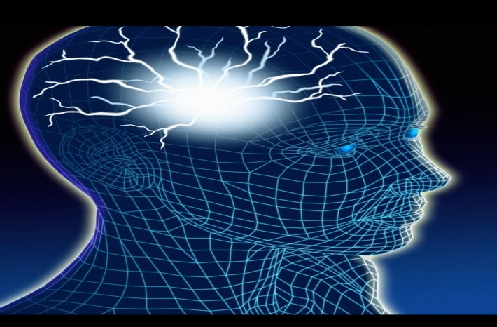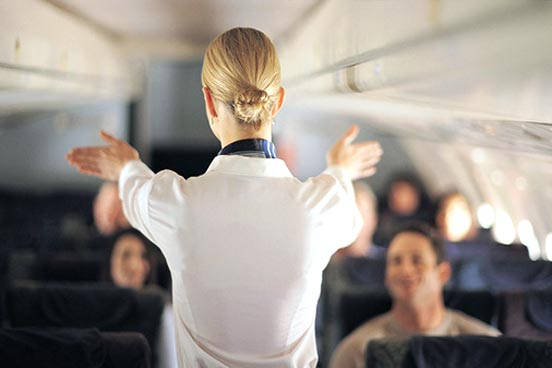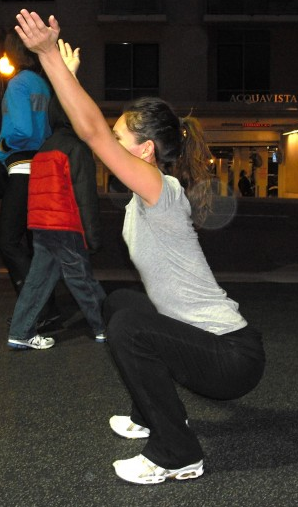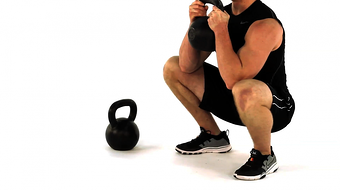Watch highlights from Cal Dietz's 2011 BSMPG summer seminar presentation.
Cal's entire presentation will be available for purchase shortly on BSMPG. Stay tuned for details.
Posted by Boston Sports Medicine and Performance Group on Fri, Oct 21, 2011 @ 09:10 AM
Topics: BSMPG, athletic training conference, boston hockey summit, athletic training, athletic training books, Cal Dietz
Posted by Boston Sports Medicine and Performance Group on Wed, Oct 19, 2011 @ 07:10 AM


Clare C. Frank DPT, MS, OCS, FAAOMPT
Dr. Frank received her physical therapy degree from Northern Illinois University. She completed the Kaiser Permanente Orthopedic Residency program in 1993 while working on her Master of Science degree in Physical Therapy at University of Southern California. She received her post-professional doctorate degree from Western University of Health Sciences, Pomona, California 2004. She is a board certified specialist in Orthopedic Physical Therapy and a fellow in the American Academy of Orthopedic Manual Physical Therapy. Her clinical career has been greatly influenced by Shirley Sahrmann PT, PhD, and the Prague School of Manual Medicine faculty, namely, the late Vladimir Janda MD, Karel Lewit MD, and Pavel Kolar PT, PhD.
Dr. Frank practices at a private clinic in Los Angeles, California. She has been instrumental in setting up the Movement Science Fellowship at Kaiser Permanente, Los Angeles. She has served on the medical team for the 2009 World Figure Skating Championships in Los Angeles, as well as the injury prevention team for the Chinese Olympic Teams 2010/11. She currently teaches in the U.S. and internationally and has co-authored “Assessment and Treatment of Muscle Imbalances: The Janda Approach”

Marcela Safarova PT, PhD
Dr. Safarova received her physical therapy training and completed her doctoral studies from Charles University. She is the head physiotherapist at Motol Hospital, a large teaching hospital associated with Charles University in Prague, Czech Republic. Dr. Safarova specializes in the rehabilitation of the locomotor system. She is also a certified Vojta therapist and has trained and works with both Professors Pavel Kolar and Karel Lewit. She also serves as an adjunct lecturer for both medical physiotherapy students at the university. She currently serves as an instructor for Professor Kolar’s courses both in Prague and internationally
ATTENTION: This course is limited to 30 seats only! Once seats are filled registration will close. Sign up before you miss this once in a lifetime learning opportunity.
Topics: basketball conference, basketball training programs, BSMPG, athletic training conference, Craig Liebenson, Charlie Weingroff, Barefoot in Boston, Clare Frank, DNS
Posted by Boston Sports Medicine and Performance Group on Mon, Oct 17, 2011 @ 07:10 AM

"Heads Up to Clinicians: Addressing Concussion in Sports among Kids and Teens" is a free, online course, developed by CDC through support from the CDC Foundation and the National Football League, available to health care professionals. It features interviews with leading experts, dynamic graphics, and case studies and provides an overview of what you, as a health care professional, need to know about concussion among young athletes.
Topics: Basketball Related, BSMPG, athletic training conference, athletic training, athletic trainer
Posted by Boston Sports Medicine and Performance Group on Wed, Oct 12, 2011 @ 06:10 AM
I have to admit I missed the boat on the importance of manual medicine for a long time. After speaking to the best clinicians and therapists in the area there was one book that each and everyone of them, regardless of their current treatment approach, recommended I read - Greenman's Principles of Manual Medicine (Point (Lippincott Williams & Wilkins))
After recently completing this book I now know why. This book is a must for anyone treating musculoskeletal dysfunction on a daily basis. Below is a short excerpt from this book.
The Manipulable Lesion
"The acceptable term for this entity is somatic dysfunction. It is defined as impaired or altered function or related components of the somatic (body framework) system; skeletal, arthrodial, and myofascial structures; and related vascular, lymphatic, and neutral elements. Notice that the emphasis is on altered function of the musculoskeletal system and not on a disease state or pain syndrome." pg 11
DIAGNOSTIC TRIAD FOR SOMATIC DYSFUNCTION
"The mnemonic ART can express the diagnostic criteria for identification for somatic dysfunction.
“A” stands for asymmetry of related of the musculoskeletal system, either structural or functional.
“R” stands for range of motion of a joint, several joints, or region of the musculoskeletal system. The range of motion could be abnormal by being either increased (hypermobility) or restricted (hypomobility). The usual finding in somatic dysfunction is restricted mobility, identified by observation and palpation using both active and passive patient cooperation.
“T” stands for tissue texture abnormality of the soft tissues of the musculoskeletal system (skin, fascia, muscle, ligament, etc.). Tissue texture abnormalities are identified by observation and a number of different palpatory tests.
Some authors add one of two other letters to this mnemonic. “P” or a second “T”. “P” stands for pain associated with other findings, and “T” stands for tenderness on palpation of the area. Tenderness is particularly diagnostic if localized to a ligament. A normal ligament is not tender. A tender ligament is always abnormal. However, both pain and tenderness are subjective findings instead of the objective findings of symmetry, altered range of motion, and tissue texture abnormality. By the use of these criteria, one attempts to identify the presence of somatic dysfunctions, their location, whether they are acute or chronic, and particularly whether they are significant for the state of the patients wellness of illness at that moment in time. In addition to the diagnostic value, changes in these criteria can be of prognostic value in monitoring the response of the patient, not only to manipulative treatment directed toward the somatic dysfunction, but also to other therapeutic interventions." Pg 11-12
Topics: Art Horne, basketball performance, basketball resources, BSMPG, athletic training conference, boston hockey summit, boston hockey conference, barefoot strength training, barefoot training
Posted by Boston Sports Medicine and Performance Group on Sat, Oct 8, 2011 @ 07:10 AM
By Art Horne

We’ve all done it from time to time – missed lunch to work with an athlete, stayed up late to write notes on the previous day’s work or ignored a pending physician or dentist appointment because we just didn’t have time.
And although it’s usually celebrated by those you care for and rewarded by the boss everyone knows this downward cycle of ignoring one’s own health in favoring of attending to the health of others can only be headed in one direction.
So the next time you board a plane when traveling remember to listen to your flight attendant’s very important message,
“During a change in altitude, oxygen masks will drop down from the ceiling. For patients travelling with young children, be sure to put your mask on first before helping your child.”
As busy as we all are it’s important to remember that the health of those we provide services for is inherently tied to our very own. It’s tough to continue to help others if you haven’t first helped yourself.
Topics: Art Horne, basketball conference, BSMPG, athletic training conference, athletic training books, barefoot strength training
Posted by Boston Sports Medicine and Performance Group on Fri, Sep 30, 2011 @ 07:09 AM
A nice story to share with other health care professionals. Support great athletic trainers by advocating for more of their time to be dedicated to specialty health care services such as emergency care and musculoskeletal evaluation, treatment and rehabilitation!
Topics: BSMPG, athletic training conference, athletic training, athletic trainer
Posted by Boston Sports Medicine and Performance Group on Thu, Sep 29, 2011 @ 08:09 AM
Missed this summer's BSMPG summer seminar?
Wished you could have seen the authors of these books and video speak while they were in Boston?



Well now you can - We captured three groundbreaking presentations from this once in a lifetime seminar. Catch three of these Giants in action as they presented at the 2011 "Standing On The Shoulders Of Giants" Summer Seminar.
This conference was held in Boston, MA on June 3rd and 4th, 2011
Presentations by: Clare Frank - Muscle Balance and Stability, Tom Myers - Anatomy Trains and Myofascial Fitness and Charlie Weingroff - Trying to Define the Core.



Topics: Art Horne, basketball resources, basketball conference, BSMPG, boston hockey summit, athletic training, Charlie Weingroff, boston hockey conference, Tom Myers, athletic training books, barefoot strength training, Clare Frank
Posted by Boston Sports Medicine and Performance Group on Wed, Sep 28, 2011 @ 09:09 AM

BSMPG is busy working on the final details of a continuing educational opportunity that you won't want to miss!
Pencil in this 3-day learning event coming March 30th through April 1st of next year.
NO walk-ins. NO casual learners. NO nodding off after lunch is served.
This will be an intense 3-day course developed for those skilled clinicians looking to take their treatment approach to the next level and is the first of it's kind on the east coast!
Location: Northeastern University, Boston MA, USA
Details coming soon!
Topics: Art Horne, BSMPG, athletic training conference, Charlie Weingroff, Clare Frank
Posted by Boston Sports Medicine and Performance Group on Tue, Sep 27, 2011 @ 07:09 AM
by Art Horne
Since squatting and the decision to squat or not comes up more often than any other subject when it comes to sports medicine and performance professionals, we decided to tackle this subject head on in this latest post. Everyone should be able to squat - there I said it. So whether you'll be teaching it after surgery, or training it in the weight room it's important that the beliefs and concepts that you have pertaining to the squat is the same as those that you work with in order to achieve the highest level of athlete success.
Below is an outline which we have used in a staff journal club to finalize our teaching progressions and teaching cues for the squat pattern while also getting everyone on the same page and on board with the importance of squatting.

Squat Goal: all athletes should be constantly working towards a score of three on their OH Squat test. Whether they initially present to Sports Medicine with back, knee, hip or other LE injury or pain, all care and performance training providers should be able to look at this movement pattern and address any movement concerns IN ADDITION to their traditional rehab or performance program regardless of initial pain or injury presentation.
FMS Squat Test: see functionalmovement.com for complete details
(Have a staff member certified or familiar with the FMS review testing criteria, followed by staff members from both staff’s testing and evaluating each other).

Only qualified medical professionals should deal with pain and painful movement patterns. If a student-athlete experiences pain they should be referred to the athletic trainer coordinating their care at the college level or another health care professional if you are working in the private sector. Although many “painful” maneuvers are often neglected and played down by the student-athlete, seldom do those with pain during a simple bodyweight squat ever go on to compete at a high level without future injury and time loss.
Since PAIN is complicated, multifactorial and often unpredictable, a painful pattern should be “broken down” to its component parts so to find the underlying pain generator or limiting factor. The Selective Functional Movement Assessment TM offers health care providers a systematic approach and a common movement language among all staff members.
(Have a staff member certified or familiar with the SFMA squat breakout present this algorithm to the remainder of your staff and then follow up by having individuals from both groups evaluate each other while identifying the limiting factor within each individual’s squat pattern.
SFMA Squat Breakout:
1. Overhead deep squatting pattern
2. Fingers interlocked behind neck into deep squat position
a. This position lowers the difficulty by not having the shoulders flexed vertical
b. Removes the upper body components and reduces the level of dynamic stability needed to perform the squat.
3. Assisted Squat from ATC into deep squat
a. Athlete holds hands of evaluator while performing squat.
b. Looks at the true symmetrical mobility of the lower body (hips, knees, ankles) without the requirement of dynamic stability.
4. Half kneeling Dorsi-flexion (test for ankle ROM)
a. Place foot on weight bench and lean forward over the foot as far as possible without the heel coming off the bench.
b. The knee should move forward out past the toes at around 4 inches.
c. Repeat for both sides.
5. Supine Knees-to-chest – test for anatomical limitations at hip in non-weight bearing position.
a. Looks at mobility of the hips, knees and spine in a non-weight bearing position.
b. Can help differentiate a mobility vs. stability problem
c. Have the patient grab both shins and attempt to touch their thighs to their lower rib cage.
d. If they can’t get their calves to touch their thighs due to knee tightness, have them grab their thigh instead and repeat thin maneuver. (This will help differentiate between hip and knee mobility issues. If in this position they still can’t get their thighs to touch their rib cage, then there is a potential hip dysfunction).
Since so many of us sit on our butts all day it’s no surprise that our butts are rarely working to the level they should be.
(Unless of course you use your butt for a simple paper weight – then your butt works just fine).
Because the squat is the end goal for all athletes in terms of both health and performance, it’s important for athletic trainers and other health care professionals to begin grooving this pattern early on in the rehabilitation process so that there is not only a seamless transition from one Sports Medicine to Performance Training, but also a clear message when it comes to cueing and technique among all professionals on staff. In order to have everyone speaking the same squat language, starting everyone back on the ground and building a solid and logical progression from post-surgical all the way to high performance only makes sense while the entire staff is playing nice together.
Below is a starting point with a few teaching cues to get the conversation started and a solid progression built between the two groups. (I have purposefully not included a complete progression below so to force the issue with your own staff. People tend to complete tasks fully if they have had an opportunity to contribute to so be sure to ask for feedback from both staffs – Sports Medicine and Strength & Conditioning).
Back to Basics: (Supine Table Series)
1. Teach Glute Max w/ Bridge
2. Supine Bridge w/ Thera-band
3. Supine Bridge w/ Marching
4. Single Leg Hip Bridge
Teaching Points:
a. Squeeze Glutes to hold “gold coin” between butt cheeks or pretend to “crack a walnut” while bridging
b. brace core musculature as taught by Stu McGill
c. Ensure hamstrings are not dominate during exercise by palpating medial tendons.
d. Add a theraband around knees or create an ADDuction force to the knees to facilitate additional glute max contraction

1. Goblet Squat: hold Kettlebell by the horns and squat to depth (providing a weight to the anterior portion of body balances the athlete and gives an additional point of stability
2. Descend squat so that elbows touch VMO of each knee.
3. If depth is a problem “wedge” elbows inside of knees to mobilize the hips.
4. In the early stages be sure to stand behind your athlete to ensure safety – encourage thoracic extension and a flat back
5. ** use clinical judgment based on patient presentation and injury. If unsure, REGRESS activity and PERFECT – OWN THE MOVEMENT before progressing to more advanced alternatives.
READ: Squatting - An Expression Of Health
Next week: Bringing both staffs together to learn and master the hip hinge – a must for avoiding and rehabilitating back pain and also pulling big deadlift numbers!
Topics: Basketball Related, Art Horne, basketball resources, BSMPG, athletic training conference, athletic training, FMS, Barefoot in Boston
Posted by Boston Sports Medicine and Performance Group on Wed, Sep 7, 2011 @ 07:09 AM

Click HERE to listen to this interview.
In this interview, Art discusses his new book, "Barefoot in Boston: A Practical Guide to Achieving Injury Resolution and Enhancing Performance", as well as discussing some research on barefoot walking and training versus wearing shoes, what to look for in minimalist shoes, how he has incorporated barefoot training with his basketball team, and much more..(including how to take a hack saw to a basketball shoe!)
Topics: Basketball Related, Art Horne, BSMPG, functional movement screen, boston marathon, foot pain, foot fracture, barefoot strength training, Barefoot in Boston, achilles pain, barefoot running, barefoot training
“The residents who live here, according to the parable, began noticing increasing numbers of drowning people caught in the river’s swift current and so went to work inventing ever more elaborate technologies to resuscitate them. So preoccupied were these heroic villagers with rescue and treatment that they never thought to look UPSTREAM to see who was pushing the victims in.”
Learn what is hurting your feet and your performance, and how to finally train your feet the way they were meant to be.
© 2020 Boston Sports Medicine and Performance Group, LLC